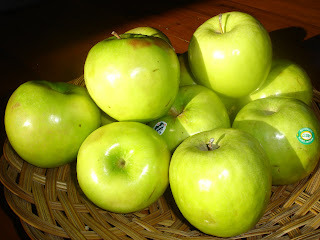
We bought a couple of wooden looking fruits from the market today. We were told by our regular fruit seller to choose fruits with the richer red colour on the skin, the richer the flavour. Also, the heavier it is for its size, the more juice and flavour. As usual, ending his final advice for me to ponder not until I get home to find out, "Look for a little cracking around the crown or stem end. That means there is so much juice inside, those tiny jewels are bursting to get out". Just in case, you are still wondering what we will be cracking when we reach home, it is the pomegranate — of which only the seeds are edible — even is mentioned several times in the Bible, and ornamental depictions of pomegranates, in Hebrew, grace the tops of many Torah scrolls.

Most Singaporeans are able to recognise this fruit in its miniature form because dwarf pomegranate are widely grown as an ornamental in pots in the gardens and almost along every corridor in the housing estates. Steeped in history and romance and almost in a class by itself, the pomegranate is one of the oldest cultivated fruit trees in the world, the pomegranate has appeared in Greek mythology and hymns dating back to the 7th century, and in Singapore it is rather commonly planted not as a fruit but instead cherished as a symbol of good fortune, as well as of fertility and prosperity. This veneration of the plants is rooted with some old Singaporean Taoists rituals in cleansing away bad luck and inauspicious events. My mother would place a pomegranate twig in a basin of water outside the threshold and one is expected to use the water on the face and arms and symbolically wash away any bad luck and ill omens before entering the house after atteding a funeral or wake. I believe this once ancient practice continues today, and maybe finding new meaning in every Taoist household.



